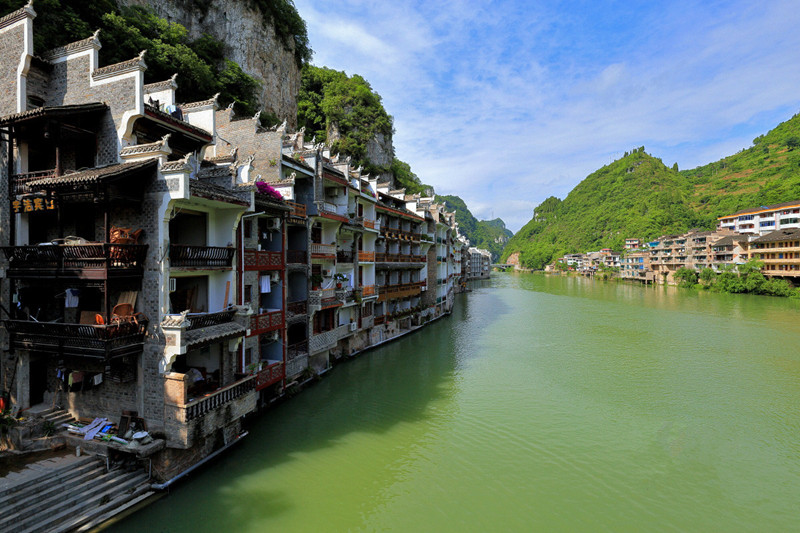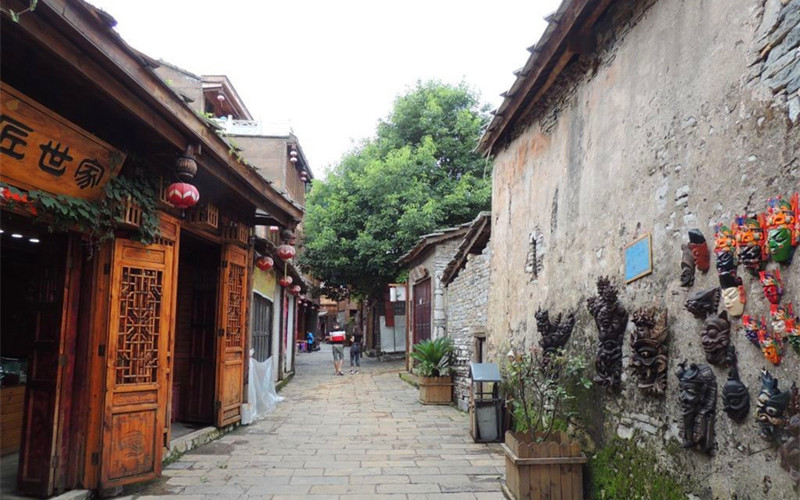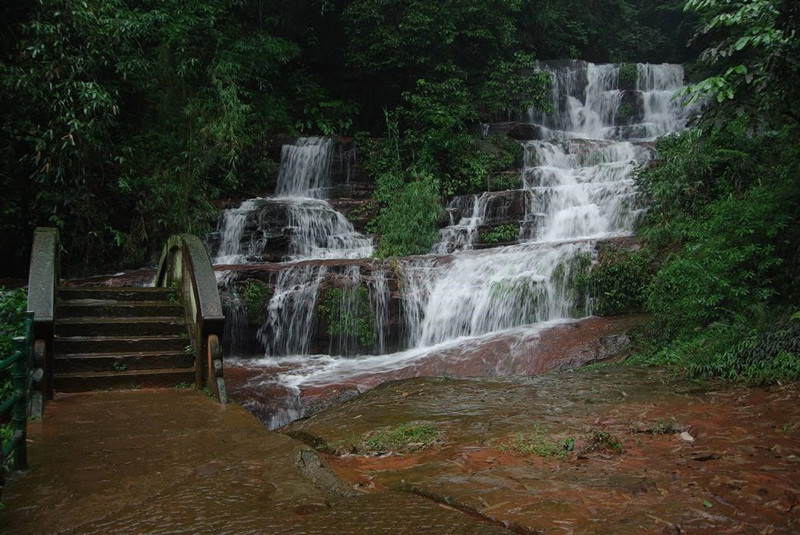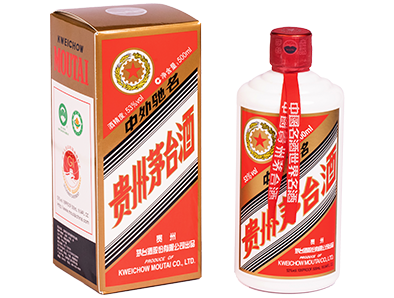
How to Plan Guizhou Tour
Guizhou (贵州) sits on the Yunnan–Guizhou Plateau at an average altitude of about 1,100 m. It has a mild, humid climate; spring (March–May) and autumn (September–November) are the best times to visit. A stay of 5–7 days allows you to experience the variety of Yellow Fruit Tree Waterfall (黄果树瀑布), Xijiang Qianhu Miao Village (西江千户苗寨), and Libo Small Seven Holes (荔波小七孔), among others. The most convenient ways to get around are by high-speed rail, intercity bus, or self-drive. Local cuisine is characterized by sour, spicy, and fragrant flavors—representative dishes include Sour Soup Fish (酸汤鱼) and Glutinous Rice (糯米饭). Average annual temperatures range from 12–16 °C, with rainy season from May to August. When packing, follow a “layering” approach in spring/fall, rain gear for summer, and warm clothes for winter; bring good hiking shoes and a compact umbrella or raincoat.
1. Best Time to Visit Guizhou (贵州)
-
Spring (March–May): Blossoms and flower seas, daytime highs ~11–19 °C—ideal for cherry-blossom viewing and visiting Miao villages.
-
Autumn (September–November): Stunning fall foliage and rice-harvest colors, highs ~12–21 °C—clear skies highlight lakes and mountains.
-
Summer (June–August): Warm (18–28 °C) and wet—great for waterfall vistas and rafting, but bring waterproof gear.
-
Winter (December–February): Cool (0–10 °C) but seldom severe; many hot springs (e.g., Shiqian Hot Springs 石阡温泉, Jianhe Hot Springs 剑河温泉) are open.
2. Recommended Length of Stay
-
5–7 days:
-
2–3 days around Yellow Fruit Tree Waterfall (黄果树瀑布) and Tianlong Tunbao (天龙屯堡)
-
2 days at Xijiang Qianhu Miao Village (西江千户苗寨) and Zhenyuan Ancient Town (镇远古镇)
-
1–2 days exploring Libo Small Seven Holes (荔波小七孔) and Mount Fanjing (梵净山)
-
-
10+ days: If you wish to add the Dong drum-tower villages (侗乡鼓楼), Danzhai Wanda Town (丹寨万达小镇), or Bijie Hundred-Mile Azalea (毕节百里杜鹃), extend accordingly.
3. Must-See Attractions
Yellow Fruit Tree Waterfall (黄果树瀑布)
The Yellow Fruit Tree Waterfall is China’s largest waterfall cluster, with a main drop of 77.8 m and a width of 101 m, creating a magnificent “water curtain.”
At peak flow (July–September), the discharge can exceed 18,000 m³/s, producing thunderous sound and a permanent rainbow on sunny days.
Visitors can access multiple viewing platforms—including the Water‐Curtain Cave behind the falls—for 360° perspectives.

Libo Small Seven Holes (荔波小七孔)
Libo Small Seven Holes is a classic karst landscape of emerald pools, arched stone bridges, and limestone karst peaks set along the Xiaoqikong River.
The “Seven Holes” refer to natural arches and caves—each offering photogenic reflections in glass-like emerald water.
A wooden boardwalk trail of about 3 km winds through subtropical rainforest, passing waterfalls, rapids, and flora endemic to the Wuling Mountains.

Mount Fanjing (梵净山)
Mount Fanjing is a UNESCO World Natural Heritage site famed for its “mushroom stone” peaks, ancient monastic sites, and mist-shrouded cloud seas.
Its two main peaks—Red Cloud Golden Summit and Old Golden Summit—rise over 2,500 m, accessible via a recent cable‐car installation that shortens the climb.
Biodiversity is remarkable: over 2,100 higher-plant species and 600 vertebrate species, including endangered Guizhou snub-nosed monkeys.

Xijiang Qianhu Miao Village (西江千户苗寨)
Xijiang Qianhu Miao Village is the world’s largest Miao settlement, home to over 8,000 Miao people across 1,000+ households.
Distinctive wooden stilt houses rise in terraces against hillsides; village festivals feature Lusheng (reed-pipe wind instrument) performances and traditional silver jewelry.
Guided cultural tours cover batik making, traditional embroidery workshops, and evening drum-tower dances.

Zhenyuan Ancient Town (镇远古镇)
Zhenyuan Ancient Town dates to the Qin dynasty (c. 3rd century BCE), with over 2,000 years of continuous settlement on a peninsula encircled by the Wuyang River.
Its stone‐arched Gongyuan Bridge and narrow cobbled alleys evoke Ming–Qing imperial architecture, while riverside teahouses offer boat-slice views.
Nearby attractions include the Black Dragon Cave (Heilongdong) scenic area and Qinglong Cave (“Green Dragon” limestone caverns).

Tianlong Tunbao (天龙屯堡)
Tianlong Tunbao is a Ming‐era fortified military settlement founded in 1381 CE, where descendants still maintain traditional Tusi (土司) clan culture.
Key features: fortified stone walls, earth‐and‐wood houses, ancestral halls, and daily Tunbao “living history” performances reenacting ancient military drills.

Chishui Danxia (赤水丹霞)
Chishui Danxia features red sandstone cliffs sculpted into towers, spires, and canyons over millions of years, recognized as a Global Geopark.
The “Red Water” river—named for its reddish banks—winds through towering Danxia formations, with scenic hiking paths and photography platforms.
The area also hosts red-tourism sites commemorating the 1935 Zunyi Conference of the Long March.

4. Getting Around Guizhou (贵州)
-
High-Speed Rail: Guiyang (贵阳) is linked to Beijing, Shanghai, Guangzhou, Chengdu, etc., with a dense intercity network.
-
Intercity Buses: Frequent coaches connect Guiyang, Kaili (凯里), Anshun (安顺) and most scenic spots.
-
Self-Drive / Private Car: Mountainous roads favor SUVs or 4WD; main arteries are G60 Hukun Expressway (沪昆高速) and G75 Lanhai Expressway (兰海高速).
-
Local Transit & Ride-Hailing: Urban buses and Didi are convenient in Guiyang, Kaili, and near major attractions.
5. Local Cuisine of Guizhou (贵州)
Flavor Profile & Key Ingredients
Guizhou dishes balance tangy sourness (源自发酵蔬菜和米酒) with clean heat from fresh and dried chilies, creating a refreshing but piquant taste.
Sour Soup Broth (酸汤): The hallmark of Miao-style cooking, made by fermenting cooked rice, local rice wine, wild tomatoes, chilies, garlic, and ginger for several days .
Pickled Vegetables (腌菜): Cabbage, radish, and mustard greens are naturally fermented in salt for 3–5 days, supplying both acidity and umami
Chili Preparations:
Hu-la (糊辣): Heat-dried chili powder.
Ciba-la (糍粑辣): Fresh chili paste or oil-simmered chili.
Zao-la (糟辣): Minced chili fermented with ginger and garlic.
Laoguo-la (老锅辣): Chili flakes.
Houttuynia (折耳根): An herb with a citrusy, fish-like aroma, often stir-fried with bacon or used in dipping sauces.
Signature Main Dishes
Sour Soup Fish (酸汤鱼)
Fresh river fish (often carp or grass carp) poached in aromatic sour soup, served bubbling in a tabletop brazier.
The broth’s balance of chili, fermented tomato, and garlic cleanses the palate and cuts grease.

Spicy Chicken (辣子鸡)
Bite-sized chicken fried with dried chilies, Sichuan peppercorns, and garlic, yielding a crisp bite and smoky aroma
Guizhou’s version uses laoguo-la chili flakes for deeper color and earthier heat.

Pickled Chili Beef (泡椒牛肉/剁椒牛肉)
Thin-sliced beef stir-fried with house-made pickled chilies, celery, bamboo shoots, and wood ear fungus.

Crispy Fish in Vinasse (糟辣鱼)
Whole river fish marinated in zao-la chili sauce, deep-fried to crisp perfection, then briefly braised in a savory vinasse (distillery lees) sauce .
Zhuangyuan Pig’s Trotter (状元猪蹄)
Braised pork trotters in brown sugar, soy, star-anise, and jujube—tender, gelatin-rich, and subtly sweet to offset the region’s spice .

Popular Snacks & Street Foods
-
Si Wa Wa (“Silk Doll” Spring Rolls, 丝娃娃): Thin rice wrappers filled with shredded vegetables, bacon, and herbs, served with a tangy peanut-chili dip.
-
Changwang Noodles (肠旺面): Wheat-egg noodles in chili oil broth topped with pig’s intestine and blood jelly—rich, spicy, and savory.
-
Love-Tofu Wraps (恋爱豆腐果): Fried tofu pockets stuffed with minced pork and chili, best enjoyed hot off the griddle .
-
Cui-shao (脆哨): Deep-fried marinated pork cubes, crispy on the outside and moist within, eaten alone or tossed into noodles and rolls .
.jpg)
Condiments & Dipping Sauces
-
Spicy Dipping Sauce (蘸水): A ubiquitous table sauce of chopped chilies, garlic, scallion, sesame oil or soy, and often houttuynia—each household has its own recipe
-
Chinese Black Vinegar: A mild, slightly sweet vinegar used to brighten fried snacks and dumplings
Local Beverages & Alcohol
-
Maotai (茅台): World-famous baijiu from Maotai Town, distilled from sorghum and wheat, prized for its umami and complexity
-
Miao Rice Wine (苗家米酒): Fermented glutinous-rice wine with floral aromatics, served warm during festivals
-
Huaxi Tea (花溪茶): Fragrant black tea from Huaxi District, often blended with dried fruits or spices for a refreshing brew
6. Climate & Weather
-
Average Annual Temperature: 12–16 °C, with mild seasonal variation.
-
Precipitation: 1,000–1,400 mm annually; ~60% falls from May to August.
-
Sunshine: Around 1,000 hours/year; winters and springs are often cloudy or foggy.
-
Climate Type: Humid mid-subtropical monsoon—no extreme cold or heat.
7. Altitude & Topography
-
Average Elevation: ~1,100 m on the eastern edge of the Yunnan–Guizhou Plateau.
-
Range: Lowest valleys ~68 m; highest peaks (e.g., Jiucaiping 韭菜坪) up to ~2,900 m.
-
Terrain: About 87% mountain and hill—karst peaks, Danxia cliffs, deep gorges.
8. Packing Tips for a Guizhou (贵州) Tour
Clothing
-
Spring/Autumn: Layered long sleeves + fleece or softshell jacket.
-
Summer: Quick-dry tees, sun hat, lightweight rain jacket.
-
Winter: Down jacket or heavy coat + thermal base layers.
Footwear & Accessories
-
Hiking Shoes: Sturdy, slip-resistant for muddy mountain trails.
-
Rain Gear: Compact umbrella and/or packable raincoat.
-
Sun Protection: Hat, sunglasses, sunscreen.
-
Daypack: Carry water, snacks, first-aid kit, power bank.
Other Essentials
-
Insect Repellent: Useful in forested or riverside areas.
-
Medicine Kit: Antibiotics, antidiarrheals, topical analgesics.
-
Electronics: Portable charger, power strip.












